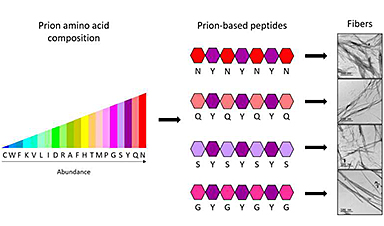Researchers of the Institute of Biotechnology and Biomedicine (IBB-UAB) have generated four peptides, molecules smaller than proteins, capable of self-assembling in a controlled manner to form nanomaterials. The research, published in the journal ACS Nano, was conducted by Salvador Ventura, Marta Díaz Caballero and Susanna Navarro (IBB-UAB), and included the collaboration of Isabel Fuentes and Francesc Teixidor (Institute of Materials Science of Barcelona, ICMAB-CSIC).
In biotechnology, generating functional synthetic amyloid structures to form nanostructures by imitating the natural generation process is not new. The assembly of proteins into stable fibres allows creating supramolecular shapes that no isolated protein can create, and which are used as nanoconductors, photovoltaic structures, biosensors and catalysts.
Quite recently, researchers began synthesizing prion protein sequences to form nanomaterials. The interest in these sequences lies in the fact that the proteins assemble in a slower and more controlled manner, forming highly ordered, nontoxic nanostructures. However, the fact that the sequence is so long, with over 150 amino acids, makes it very difficult and expensive to synthesise.
“We have demonstrated that an adequate design can permit the size of synthetic prion sequences to be reduced down to only 7 amino acids, while conserving the same properties. The four peptides we have fabricated are the shortest structures of this type created until now, and are capable of forming stable fibril assemblies,” says Salvador Ventura, researcher at the IBB and the UAB Department of Biochemistry and Molecular Biology.
Image Credit: Credit: IBB-UAB
News This Week
Platelet-inspired nanoparticles could improve treatment of inflammatory diseases
Scientists have developed platelet-inspired nanoparticles that deliver anti-inflammatory drugs directly to brain-computer interface implants, doubling their effectiveness. Scientists have found a way to improve the performance of brain-computer interface (BCI) electrodes by delivering anti-inflammatory drugs directly [...]
After 150 years, a new chapter in cancer therapy is finally beginning
For decades, researchers have been looking for ways to destroy cancer cells in a targeted manner without further weakening the body. But for many patients whose immune system is severely impaired by chemotherapy or radiation, [...]
Older chemical libraries show promise for fighting resistant strains of COVID-19 virus
SARS‑CoV‑2, the virus that causes COVID-19, continues to mutate, with some newer strains becoming less responsive to current antiviral treatments like Paxlovid. Now, University of California San Diego scientists and an international team of [...]
Lower doses of immunotherapy for skin cancer give better results, study suggests
According to a new study, lower doses of approved immunotherapy for malignant melanoma can give better results against tumors, while reducing side effects. This is reported by researchers at Karolinska Institutet in the Journal of the National [...]
Researchers highlight five pathways through which microplastics can harm the brain
Microplastics could be fueling neurodegenerative diseases like Alzheimer's and Parkinson's, with a new study highlighting five ways microplastics can trigger inflammation and damage in the brain. More than 57 million people live with dementia, [...]
Tiny Metal Nanodots Obliterate Cancer Cells While Largely Sparing Healthy Tissue
Scientists have developed tiny metal-oxide particles that push cancer cells past their stress limits while sparing healthy tissue. An international team led by RMIT University has developed tiny particles called nanodots, crafted from a metallic compound, [...]
Gold Nanoclusters Could Supercharge Quantum Computers
Researchers found that gold “super atoms” can behave like the atoms in top-tier quantum systems—only far easier to scale. These tiny clusters can be customized at the molecular level, offering a powerful, tunable foundation [...]
A single shot of HPV vaccine may be enough to fight cervical cancer, study finds
WASHINGTON -- A single HPV vaccination appears just as effective as two doses at preventing the viral infection that causes cervical cancer, researchers reported Wednesday. HPV, or human papillomavirus, is very common and spread [...]














Leave A Comment